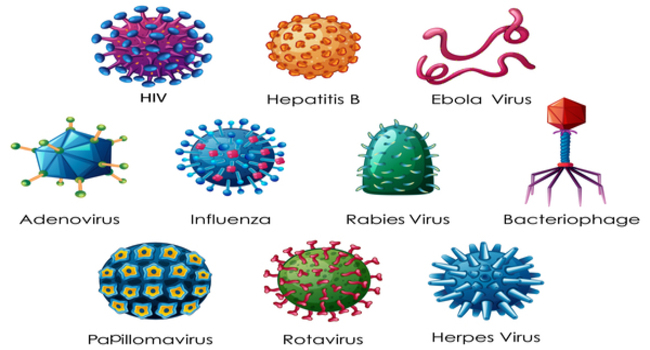What is Virology?
- Virology is the study of viruses and virus-like agents including their taxonomy, disease-producing properties, culture, genetics, structure, replication, classification, and pathogenesis. The field of virology is important in understanding and combating many human, animal, and plant diseases caused by viruses such as influenza, HIV, ebola, and many others.
- Virology is the scientific study of viruses, which are small infectious agents that can infect a wide variety of living species such as animals, plants, and even other microorganisms. Virology is a discipline of microbiology that is important in understanding viral illnesses, virus biology, and developing techniques to regulate and battle viral infections.
- Virology is a dynamic field that continues to evolve as new viruses are discovered, and our understanding of existing viruses deepens. It is of great importance in public health, agriculture, biotechnology, and various other scientific and medical fields. The knowledge and tools developed in virology are instrumental in addressing viral infections, developing vaccines, and managing viral diseases that impact human and animal health.

Importance of Virology
Understanding Viral Diseases:
- Virology plays a crucial role in understanding the aetiology (cause) of various infectious diseases caused by viruses. This knowledge is essential for the development of effective preventive measures, diagnostics, and treatments.
Public Health:
- Virology contributes significantly to public health by providing insights into the epidemiology and transmission of viral infections. This information is critical for the development of public health strategies, vaccination programs, and the control of infectious disease outbreaks.
Vaccination Development:
- Virologists are instrumental in developing vaccines against viral diseases. By studying the structure, replication mechanisms, and immune responses to viruses, researchers can design vaccines to prevent infections, saving countless lives and reducing the burden on healthcare systems.
Antiviral Drug Development:
- Understanding the molecular processes of viral replication allows scientists to identify potential drug targets. This knowledge is essential for the development of antiviral drugs that can specifically target and inhibit the replication of viruses, aiding in the treatment of viral infections.
Diagnostic Tools:
- Virology is crucial for the development of diagnostic tools, such as PCR (Polymerase Chain Reaction) tests, serological assays, and other methods used to detect viral infections. Accurate and timely diagnosis is essential for effective patient management and the prevention of disease spread.
Emerging Infectious Diseases:
- As the world faces new and emerging infectious diseases, virology becomes pivotal in quickly identifying and characterizing novel viruses. This is vital for implementing containment measures, understanding transmission dynamics, and developing strategies to mitigate the impact of emerging threats.
Virus
A virus is a tiny, infectious particle that replicates only inside living cells of organisms such as plants, animals, and bacteria. Viruses are noncellular, microscopic particles that are composed of genetic materials and proteins that can invade living cells.
Taxonomy of Virus
A universal taxonomic classification of viruses is carried out by the International Committee on Taxonomy of Viruses (ICTV). According to ICTV, the classification is as follows:
- Order – virals
- Family – viridae
- Subfamily – virinae
- Genus – virus
- Species – virus
Characteristics of Virus
- They do not have a cell nucleus.
- They do not have an organized cell structure.
- Viruses have either DNA or RNA as their genetic material, but not both.
- Obligate intracellular, unable to self-replicate.
- Viruses are unable to replicate outside a host cell and therefore require living cells to reproduce.
- Viruses do not have a system to produce ATP
Types of Viruses
1. RNA Viruses:
The virus that possesses RNA as genetic material is called RNA virus. They can either be single-stranded RNA( ssRNA) or double-stranded RNA (dsRNA). RNA viruses are known for their high mutation rates, which allow them to adapt quickly to changing environments. Vaccines and antiviral drugs are used to prevent and target RNA viral infection, but their effectiveness can vary depending on the virus and the specific stains or surface.
There are three main types of RNA viruses:
(A). Positive-sense RNA Viruses:
- It is a type of virus containing a positive sense single-stranded RNA, It is similar to mRNA, These viruses have an RNA genome that can be directly translated by host cells into proteins.
- In the hosts, once the viral proteins are produced, they recruit RNA for the production of viral replication complexes.
The replication of the virus advances through the double-stranded intermediates of RNA. - Some examples are – echovirus, common cold, and poliovirus.
(B). Negative.-sense RNA Viruses:
- It refers to the type of single-stranded RNA virus with genetic content being the antisense strand of the viral mRNA, it must be converted into Positive-sense RNA before translation.
- Some examples are – the Ebola virus, influenza virus, etc.
(C). Retroviruses:
- These RNA viruses have a unique replication cycle that involves the conversion of their RNA genome using the enzyme reverse transcriptase. HIV is a well-known retrovirus.
2. DNA Viruses:
The virus that possesses DNA as genetic material is called a DNA virus, They are DNA dependent and they replicate using DNA polymerase. They are usually dsDNA but in some cases, they can either be ssDNA.
DNA viruses can be further classified into two main categories:
(A). Single-stranded DNA (ssDNA) Viruses:
- The genetic material of these viruses is a single strand of DNA. Parvoviruses, which can infect animals, and the Circoviridae family of viruses, which harm birds and pigs, are examples of ssDNA viruses.
(B). Double-Stranded DNA (dsDNA) Viruses:
- The genetic material of these viruses consists of two complementary strands of DNA. They are further classified into numerous genera and families, each with their unique traits. Herpesviruses (such as Epstein-Barr virus and herpes simplex virus) and poxviruses (such as smallpox virus and vaccinia virus) are a few well-known examples of dsDNA viruses that infect humans.
Classification: Based on the types of the hosts.
Here are some common categories of DNA viruses based on host types:
(A). Animal Virus:
- Herpesviruses: Humans and a variety of other animals can contract these viruses. Examples include the varicella-zoster virus (VZV), Epstein-Barr virus, and herpes simplex virus (HSV).
- Poxviruses: These pathogens are known to impact humans, including the smallpox virus (variola virus), which infects a variety of animals.
(B). Plant Virus:
- Caulimoviruses: Spread by insects, these DNA viruses affect plants and cause disease.
- Geminiviruses: Geminiviruses are transmitted by insects and infect plants as well.
- Pararetroviruses: Similar to retroviruses, these viruses replicate via reverse transcription but have a DNA genome. Cauliflower mosaic virus (CaMV) and banana streak virus are two examples.
(C). Bacterial Virus:
- Bacteriophages (Phages): These are viruses that infect bacteria. They are utilized in molecular biology and biotechnology studies, including phage therapy, and have a DNA genome.
(D). Archaeal Virus:
- These viruses affect a class of microorganisms called archaea, which is different from bacteria and eukaryotes. They are found in extreme environments like hot springs and deep-sea hydrothermal vents.
It’s important to note that some DNA viruses can infect a wide range of hosts, including humans and animals. The classification of DNA viruses is based on a combination of factors, including the structure of the viral genome, the mode of replication, and the types of host organisms they can infect.
References
- https://www.news-medical.net/health/What-is-Virology.aspx
- https://journals.asm.org/doi/full/10.1128/jvi.00151-09
- https://www.sciencedirect.com/topics/agricultural-and-biological-sciences/virology
- https://www.ncbi.nlm.nih.gov/pmc/articles/PMC7152233/
- https://virologyj.biomedcentral.com/

4 thoughts on “Introduction to Virology”